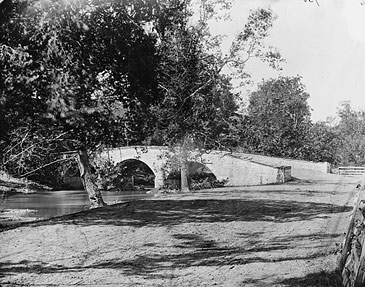
Burnside Bridge,
Antietam National Battlefield
Sharpsburg, Maryland
American Sycamore
TreeSharpsburg, Maryland

Photo by Alexander Gardner, 1862. Courtesy Smithsonian American Art Museum
threat
The location of the Burnside Bridge Sycamore is generally favorable. Owing to the high degree of historical integrity maintained around Burnside Bridge, its present setting chiefly mirrors the naturalistic conditions of 1862. Additionally, in 1995 Antietam National Battlefield staff and volunteers began reforesting the park’s Civil War era woodlots, largely removed during the late nineteenth and early twentieth-centuries. In the seven years from 1995-2002 they planted 16,392 seedlings and 300 balled and burlapped trees over a fifteen acre area known as the West and North Woods. This work continues today, and combined with the sprawling pastures and open tracts of farmland within Antietam, the restored woodlots afford the tree a particularly high-quality, large-scale environmental context. Given this natural landscape, falling leaves, fruits, and twigs do not generally constitute a litter problem, and the National Park Service can recognize and combat disease and pests better than many private owners. With no other trees nearby, it has adequate room to grow, although some pruning may be necessary for the ease of visitors crossing over Burnside Bridge. A more serious potential problem centers on the tree’s roots. If their expansion threatens the stability of the bridge itself, the NPS may face a difficult decision over which resource to save at the other’s expense, and given the historical significance of Burnside Bridge, consideration would be given to remove its namesake American Sycamore. However, apart from this possibility, the tree holds the potential to live for many years. Thankfully, through 150 years or more of tree growth, thus far, the bridge has shown no signs of damage from tree roots.